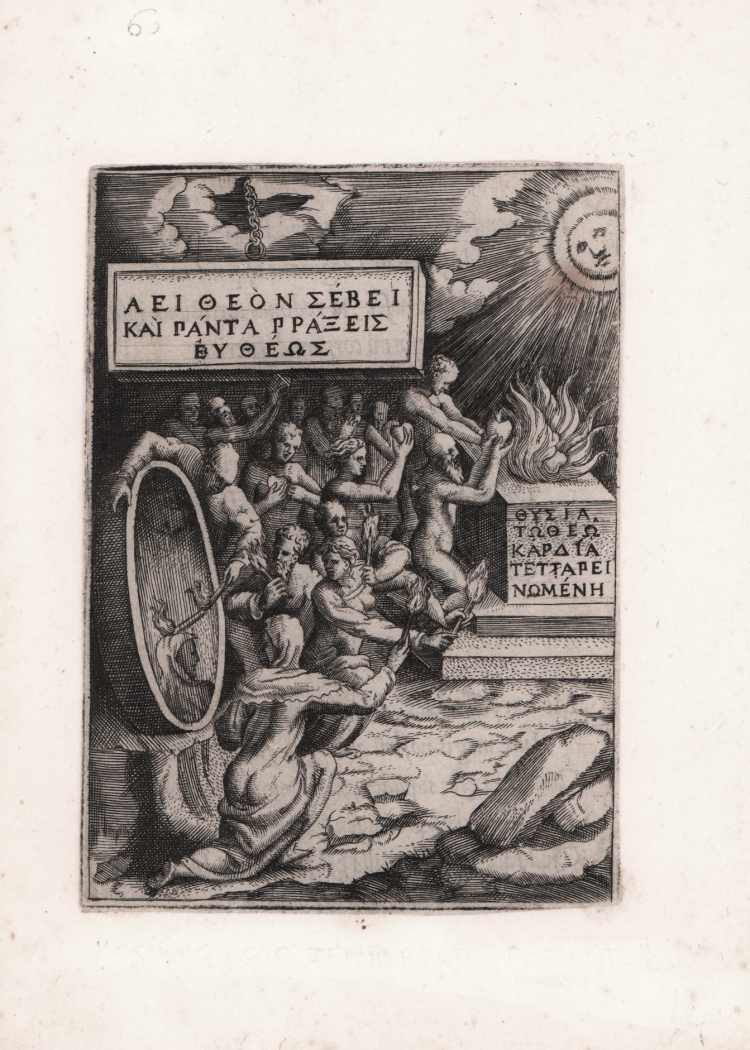



| Reference: | S35358 |
| Author | Giulio BONASONE |
| Year: | 1555 |
| Measures: | 80 x 115 mm |


| Reference: | S35358 |
| Author | Giulio BONASONE |
| Year: | 1555 |
| Measures: | 80 x 115 mm |
Engraving, 1555, without signature. A fine, earl impression of the first state of two, before Agostino Carracci retouches, printed on contemporary laid paper, very good condition.
Bonasone illustration for the Symbolicarum quaestionum, de universo genere quas serio ludebat, libri quinqu by Achille Bocchi, with 151 engraved emblems by Giulio Bonasone, after drawings by Prospero Fontana and Parmigianino.
Achille Bocchi's famous Symbolicarum quaestionum (first published in 1555), one of the most fascinating and renowned emblem books of the Italian Renaissance. Achille Bocchi (1488-1562) was a Bolognese humanist, active as a lecturer, professor and historian at the Bologna university, and a high standing personality in the cultural milieu of this city. He also founded an eponymous Academy, the Accademia Bocchiana, which included among its members professors of the Studium, philosophers and humanists, and animated the city's culture for nearly a decade, between 1546 and 1556. The Academy had its own print and Bocchi's emblem book was probably the first work published within it; also the second posthumous edition holds its own typographic record, as it stands as the first publication of the Bolognese Typographic Society, founded in 1572. The Symbolicarum quaestionum libri are composed by 151 symbols, each of whom consists of a title, a dedication, a Latin or Greek epigram, and an allegorical illustration on copperplate. In this way, with regard to its general conception and structure, the work owes a great debt to Andrea Alciato's celebrated Emblemata.
Prospero Fontana, to whom the great majority of the illustrations is to be ascribed, was a Bolognese mannerist painter, and was considered one of the best portrait interpreters of his time. He was active in Genoa, Rome, and Bologna, where he opened the important painting school that the Carracci cousins attended in their youth. A great amount of the iconographic motifs represented in the book bear the mark of the Oriental symbolism, which was mostly mediated by Filippo Fasanini's translation of Horapollo's Hieroglyphica and by Pierio Valeriano's Hieroglyphica. Moreover, one can count many mystical and biblical motifs, as well as motifs derived from Petrarch or Alexandrine erotic poetry.
Bocchi's work exerted a strong influence on later emblem writers, literary works, and artists. Many of Bocchi's symbols were especially reproduced and imitated in emblem books of the 17th century, like those by Otto van Veen and John Marston.
Bibliographic references
Bartsch / Le Peintre graveur (XV.158.237).
Giulio BONASONE (Bologna circa 1500 - Roma circa 1580)
|
Giulio Bonasone was born in Bologna in 1510; he was engraver, etcher and, as a painter, he was a pupil of Lorenzo Sabbatici.
The critics have ascribed to him 400 prints; nearly all of them are kept nowadays in the Institute of Graphic Design in Rome, widening the list of Bartsch, who had identified just 354 subjects. Bonasone started working in 1531 as copperplate engraver, as it can be seen from his S. Cecilia, and he was considered a follower of Marcantonio’s style in the last years. But Bonasone showed his own style quite soon, for Parmigianino asked him to engrave many of his works.
He lived in Rome between 1544 and 1547, working for the most important publishers of the time (Salamanca, Barlacchi, Lafrery), engraving subjects from Michelangelo, Raphael, Giulio Romano, Perin del Vaga and Polidoro da Caravaggio with his peculiar style.
|
Giulio BONASONE (Bologna circa 1500 - Roma circa 1580)
|
Giulio Bonasone was born in Bologna in 1510; he was engraver, etcher and, as a painter, he was a pupil of Lorenzo Sabbatici.
The critics have ascribed to him 400 prints; nearly all of them are kept nowadays in the Institute of Graphic Design in Rome, widening the list of Bartsch, who had identified just 354 subjects. Bonasone started working in 1531 as copperplate engraver, as it can be seen from his S. Cecilia, and he was considered a follower of Marcantonio’s style in the last years. But Bonasone showed his own style quite soon, for Parmigianino asked him to engrave many of his works.
He lived in Rome between 1544 and 1547, working for the most important publishers of the time (Salamanca, Barlacchi, Lafrery), engraving subjects from Michelangelo, Raphael, Giulio Romano, Perin del Vaga and Polidoro da Caravaggio with his peculiar style.
|